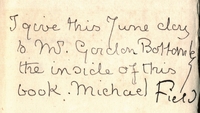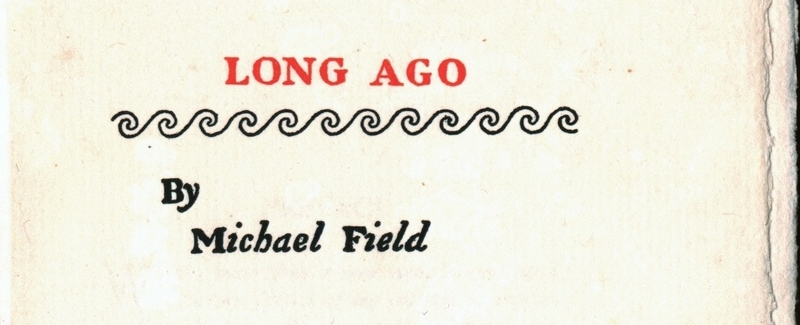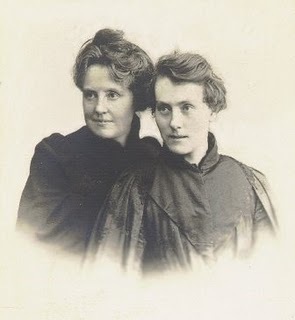Sappho Through Their Eyes: Time and Materiality in Michael Field’s Long Ago
“I give this June day to Ms. Gordon Bottomley the inside of this book.” - Michael Field, June 5, 1908.
When you open up this copy of Long Ago (1897), housed at the University of Victoria’s Special Collections, you will find two material features added by the book’s authors: an inscription written and dated by the authors and a single pressed flower secured to the next page with three pieces of tape (see Botanical Insertion). These fascinating details are absent from other copies of this book (for instance, this digitized version from Google Books) and demonstrate the importance of materiality, time, and book history to this text. This particular edition was published in 1897 in a print run of 925 copies, a relatively small number and yet still far greater than the original publication. Field published the first edition of Long Ago in 1889 with publisher George Bell and Sons with only 100 copies produced in total. Yet even in such a small print run, this copy of Long Ago is unique because of its physical features.  Field’s inscription, shown on the left, emphasizes the materiality of the book, encapsulating the essence of “this June day” within its pages—presumably referencing the flower secured to the next page, but perhaps also the words within the book. What, then, can this book tell us about time, materiality, and Victorian culture? This exhibit seeks to answer this question by exploring the relationship between the book’s physical traces, sapphic lyrics, and provenance and production.
Field’s inscription, shown on the left, emphasizes the materiality of the book, encapsulating the essence of “this June day” within its pages—presumably referencing the flower secured to the next page, but perhaps also the words within the book. What, then, can this book tell us about time, materiality, and Victorian culture? This exhibit seeks to answer this question by exploring the relationship between the book’s physical traces, sapphic lyrics, and provenance and production.
Long Ago is a collection of poems—the first poetry collection published by Michael Field—based on a translation of poetic fragments by ancient Greek poet Sappho by Henry Thornton Wharton in 1885. As such, this book is concerned with issues about translation, transformation, and time as mediated through art and writing and the Fields' own experience as dual authors navigating an extremely unconventional queer relationship. Michael Field is the pseudonym for Katherine Harris Bradley and Edith Emma Cooper, an aunt and niece who considered themselves to be married and co-wrote verse and prose under the pseudonym Michael Field. Sappho, writing around the sixth and seventh centuries BCE (precise dates unknown), survives only through fragments of her poetry that have been translated and re-translated throughout centuries. There was a resurgence of her popularity in the late nineteenth century when Field was writing. Indeed, Henry Thornton Wharton published Sappho: Memoir, Text, Selected Renderings and a Literal Translation in 1885 and the book was popular enough to merit multiple reprintings into the early twentieth century (it was reprinted in 1887, 1895, 1898, and 1907). It is Wharton’s translation on which Field bases their imitations of Sappho, using what Wharton suggests is literal translation in the book's title (see “Note” [n. p.] at the end of the digitized PDF of Long Ago). This project seeks to illuminate the complexities of translation and transformation, queer identity, and time through the unique material and textual details of UVic’s copy and posits that the material details within this copy emphasize and sentimentalize the passage of time through transformation and transfiguration.
Katherine Harris Bradley and Edith Emma Cooper are pictured on the left. Under the joint name Michael Field, they wrote plays, poetry, and also co-wrote in their journal Works and Days. Throughout this exhibit, I will refer to Bradley and Cooper as authors of this book using the name Michael Field with third-person pronouns (they/them) to acknowledge their duality as co-authors of this book. However, I will also refer to them with their own names when discussing them individually. My rationale for doing so is that they regarded themselves as unified under the name “Michael Field” and used the pseudonym not only as a pen name for publishing but also in their personal lives: Katherine’s nickname was Michael while Edith’s was Field, and the two sometimes used these nicknames in their personal correspondence. Moreover, their friends often referred to them as “the Michaels” or “the Fields.”
This exhibit will not provide extensive biographical information about Bradley and Cooper, but there is a growing amount of research and publications about them. If you are interested in learning more about them, I recommend Emma Donoghue’s We Are Michael Field (2014), Marion Thain and Ana Vadillo’s Michael Field: The Poet (2009), Mary Sturgeon’s Michael Field (1921), and the above mentioned Michael Field Diaries project.
Long Ago (1897) digitized PDF:
Click on any image in this exhibit to enlarge it and view its associated metadata or browse all objects in the Lowens Fellows site here.
Home Page ֍ Book Traces ֍ Reviving Sappho ֍ Provenance and Production ֍ About ֍ Works Cited

